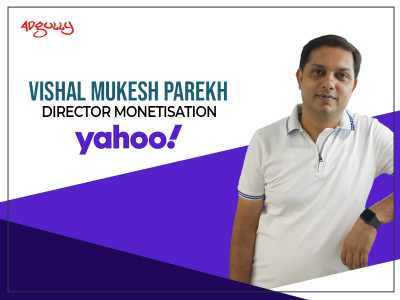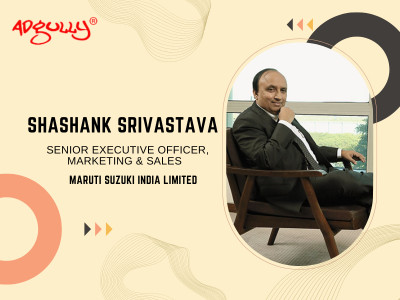DOOH will definitely be an alternative in a cookieless future: Vishal Mukesh Parekh
DOOH and pDOOH were on a swift growth path before the pandemic hit, and if anything, the relevance of this high-impact ad format has only increased in a post-COVID-19 world. Digital screens could vary with mobility curbs – COVID-related restrictions impacted traffic in shopping areas with billboards, yet at the same time, foot traffic would rise at supermarkets, with people still needing to shop for essentials. In fact, now more than ever, advertisers need tech capabilities to reach and meaningfully capture audiences’ attention ‘when’ and ‘where’ they step out.
In an exclusive conversation with Adgully, Vishal Mukesh Parekh, Director - Monetisation, Yahoo India, speaks at length about the distinct opportunities in how brands can leverage DOOH solutions, the relevance of DOOH, how DOOH can be integrated into a larger omnichannel campaign strategy and more.
What is the potency of pDOOH and DOOH solutions in the pre-pandemic vis-à-vis post-pandemic world and what are the technologies being used in this space?
SCREENXX Awards 2021 - Digital Video Content and OTT Platform, Last Date for nomination extended - Thursday, September 23, 2021 - ENTRIES OPEN
Cities in India are not opening up uniformly. By leveraging technology, working with media owners and first-party data, it is possible to model different levels of lockdown restrictions. This can help advertisers gauge and predict where it makes sense to execute DOOH campaigns based on changes or increases in ‘community mobility’ as lockdown restrictions are lifted.
DOOH is in real-time and gives brands the ‘immediacy’ to get their message out quickly as the situation evolves or even pivot their campaigns, essential in a post COVID-19 world, where brands have to be able to respond with agility.
As revenge shopping and travel surges, DOOH will see a rebound, especially as more OOH becomes digitally-enabled. DOOH supply available programmatically blends the precision targeting and ease of programmatic ad buying with the effectiveness of high-impact digital signage.
What kind of different emerging opportunities have you experienced for DOOH?
There are distinct opportunities in how brands can leverage DOOH solutions. A major advantage is the high level of contextual relevance DOOH allows. pDOOH opens up multiple targeting options for marketers that range from location, to demographic and location interest-based. More nuanced layers lead to enhanced targeting with pDOOH, where advertisers can customise and respond with dynamic displays that reach audiences based on the time of day or day of week or even based on the weather – marketers can effectively rely on the range of enhanced targeting options to reach consumers in this new normal where the situation is fluid, and no one-size-fits all campaign will work. Especially now, when brands are looking for channels to inspire users to take action, DOOH could help them do this with greater visibility, creativity and impact.
With the third-party cookie on its way out, advertisers are looking for new approaches to contextual targeting, and DOOH will definitely be an alternative in a cookieless future, with its benefit of localisation, combined with personalisation, which create interesting ways to get consumers to engage with brands. It helps that with pDOOH, creative changes can be made remotely, literally at the touch of a button, offering marketers the creative flexibility to adjust or tweak their campaigns in real time.
With 5G around the corner, brands will have an innovative canvas with DOOH to conceptualise campaigns for greater engagement, personalisation and spectacular visual impact. The use cases and technology are evolving to support touchless screens.
What are the DOOH solutions offered by Yahoo ad tech, could you share a few examples?
We were one of the first media companies to make DOOH inventory available in an automated and programmatic way through our ad platform – we made DOOH supply available programmatically through our DSP in 2019.
Since then, we have unlocked innovative DOOH solutions for advertisers. In India, our local partners include Lemma Technologies, Moving Walls, Adonmo Pvt Ltd, and our global DOOH inventory suppliers include Rubicon Project, Clear Channel Outdoor, Lamar, Zoom Media, Captivate and Hivestack, Broadsign, Vistar, and JCDecaux through a partnership with VIOOH.
Our unified DOOH solution for publishers is industry-leading and provides one source to host, manage, stream, and monetise content. In addition to our Ad Platform, we also have our Media Platform that allows streaming content possible on connected screens – this includes DOOH devices.
We also have a DOOH Campaign Planner tool, which makes it easier for advertisers to plan and visualise campaigns in their DSP interface. The planning tool enables advertisers to set targeting criteria and view available DOOH screens in a map view to better understand their placement.
How DOOH is leveraged in retail locations is fast evolving. Through our partnership with Cooler Screens in the US, a company delivering digital in-store experiences, we are providing a fully managed IoT solution and wireless connectivity to Cooler Screens and Cooler Doors to power the high resolution smart screens that deliver in-cooler contents and ads to consumers at their point of decision. Especially now, when consumers are carefully prioritising purchases, they value up-to-date information on promotions and offers at the point-of-sale, to make purchase decisions that save money.
How has the growth in the relevance of DOOH been over the years?
The relevance of DOOH has only increased over the years and this comes down to its unique advantages that will play a greater role post-COVID. DOOH offers real-time creative flexibility that marketers need as mobility and protocols change – you can’t replace a traditional billboard overnight, whereas with DOOH, creative changes can be made remotely and instantly, as soon as the situation changes. As Indians step out, it’ll be important to meet them where they are and inspire them to take action at the right time. Place-based screens, for instance, allow marketers to reach consumers at the exact moment, like serving restaurant deals on a food court screen at lunch time.
As an advertiser, you can capture the attention of your audience in places where they are more likely to be receptive to ads, in a format that is unblockable and unskippable. In addition, as consumers become wary of targeting and fraud, DOOH is one format that doesn’t present such concerns.
What are the kinds of brands that are leveraging these DOOH solutions?
Currently, we are seeing interest from brands which need to utilise one-to-many, especially categories like OEMs, Telecom, FMCG, OTT players and so on. However, given the proliferation and variety of digital screens, there are significant opportunities for different businesses, across industries and sectors.
What does the future of DOOH look like, globally and in India?
DOOH is seeing a resurgence globally as economies recover. India will be no exception. FICCI-EY’s 2021 report on the Media and Entertainment sector expects growth in transit media assets and DOOH to be faster than growth in traditional media options, comprising 44% of the segment’s revenues by 2023. It reports, “DOOH inventory continues to be appealing to marketers due to the availability of campaign tracking, data insights and contextual advertising options, which enables marketers to structure a day-part wise DOOH plan as well as implement programmatic buys.” These overlap the very benefits our clients report and why we remain upbeat on the future and potential of DOOH in India.
















Share
Facebook
YouTube
Tweet
Twitter
LinkedIn